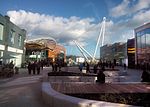Newport Centre (Wales)
Culture in Newport, WalesDarts venuesExhibition and conference centres in WalesIndoor arenas in Newport, WalesMusic venues in Newport, Wales ... and 5 more
Newport, WalesSnooker venuesSports venues in Newport, WalesSwimming venues in Newport, WalesTourist attractions in Newport, Wales

Newport Centre was a leisure centre in Newport, South Wales. The Newport Centre was located in Newport city centre on the west bank of the River Usk adjacent to the Kingsway Shopping Centre. It held events such as concerts, international business conferences and art exhibitions. The centre hosted the Welsh Open snooker tournament from 1992 until 1998, and also from 2005 until 2014. The centre also had suites overlooking the leisure pool and elsewhere; The Riverside Suite, Castle Room, Kingsway Suite, Usk Room, Treetops Suite, and the Emlyn Rooms.
Excerpt from the Wikipedia article Newport Centre (Wales) (License: CC BY-SA 3.0, Authors, Images).Newport Centre (Wales)
Usk Way, Newport Stow Hill
Geographical coordinates (GPS) Address Nearby Places Show on map
Geographical coordinates (GPS)
| Latitude | Longitude |
|---|---|
| N 51.585686111111 ° | E -2.9913027777778 ° |
Address
Usk Way
Usk Way
NP20 1ER Newport, Stow Hill
Wales, United Kingdom
Open on Google Maps










